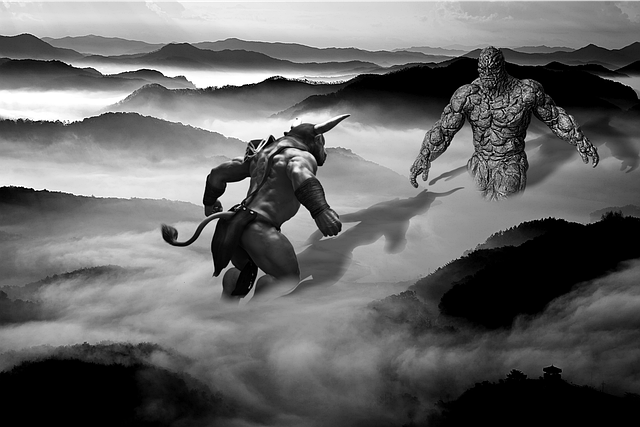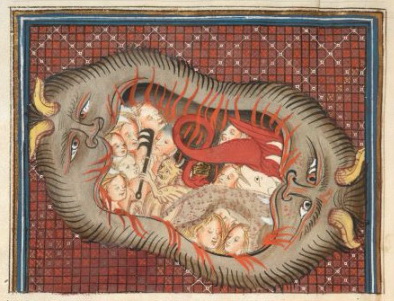John Milton’s “Paradise Lost” stands as a monument of epic poetry, and its grandeur is woven not just in the grand themes of good versus evil but also in its collages of imagery. Epic similes are the most striking elements in Book 1 where comparisons expanded into mini epics of their own, enriching the narrative and elevating the reader’s imagination.
In Book 1, Milton employs numerous elaborate similes to depict the fallen angels, their hellish abode, and their vengeful activities. An epic simile, in simple terms, is an intricate comparison that extends beyond the initial point of comparison, offering a comprehensive poetic portrayal of a suggested scene or incident in the poet’s mind. Employed for illustration and ornamentation, these similes enhance the style and bestow its dignity. They stand independently, illuminating and beautifying more than conventional narratives. These similes serve as primary tools for presenting scenes and figures beyond the scope of human experience. To emphasize the strangeness and sublimity of these depictions, Milton compares them to elements outside human experience, such as things remote, fabulous, mythological, historical, Biblical, or natural.
Titan
 The first epic simile we encounter describes the fallen angel Satan sprawled on the fiery lake of Hell. He is as large as one of the Titans, the physically huge precursors of the Greek and Roman gods who went to war with their children, gods such as Zeus (also, Jove), over control of earth and humankind. Milton’s readers would understand the war between Zeus and his fellow gods and the Titans as analogous to the war between Satan and God. It serves multiple purposes. It emphasizes Satan’s immense size and power, suggesting that he remains a formidable force even in defeat. It foreshadows the epic conflict to come, hinting at the potential for devastation Satan possesses. Furthermore, perhaps most importantly, it sets the tone for the poem, introducing a grand, almost mythological style that elevates the story beyond the earthly realm.
The first epic simile we encounter describes the fallen angel Satan sprawled on the fiery lake of Hell. He is as large as one of the Titans, the physically huge precursors of the Greek and Roman gods who went to war with their children, gods such as Zeus (also, Jove), over control of earth and humankind. Milton’s readers would understand the war between Zeus and his fellow gods and the Titans as analogous to the war between Satan and God. It serves multiple purposes. It emphasizes Satan’s immense size and power, suggesting that he remains a formidable force even in defeat. It foreshadows the epic conflict to come, hinting at the potential for devastation Satan possesses. Furthermore, perhaps most importantly, it sets the tone for the poem, introducing a grand, almost mythological style that elevates the story beyond the earthly realm.
Leviathan
 The following simile describes Satan lying on the Burning Lake, paralleling the Leviathan. Here, Milton does three things. He compares the size of Satan with the colossal sea beast; he writes about the pilot who is deceived by Leviathan (although not intentionally) and distracts the readers to the imaginative world of mythology. This quality of Milton’s similes makes them not just ornamental but generative of grandness and compatibility with the central theme of the epic.
The following simile describes Satan lying on the Burning Lake, paralleling the Leviathan. Here, Milton does three things. He compares the size of Satan with the colossal sea beast; he writes about the pilot who is deceived by Leviathan (although not intentionally) and distracts the readers to the imaginative world of mythology. This quality of Milton’s similes makes them not just ornamental but generative of grandness and compatibility with the central theme of the epic.
Autumnal Leaves
Such multiplicity of dimensions is also observed in the presentation of rebel angels. A remarkable simile likens the vast armies of fallen angels to ‘autumnal leaves.’ Derived from epic similes used by Homer, Virgil, and Dante, this simile serves as an internal commentary on the fallen angels’ miserable condition and character. So the comparison is not just about the number of leaves equal to the number of rebel angels, but the fallen leaves’ dry, lifeless condition equated with the fallen angels’ despair. Furthermore, the leaves choke the flow of water, and water is a life-giving force. Therefore, the rebel angels, compared to fallen leaves, are presented as anti-life and evil.
Locust
Another simile projecting the fallen angels as evil is seen in comparing the fallen angels to locusts. Here, Milton not only tells that Satan’s army of fallen angels is massive (countless), but he also compares them to something most people would see as wrong – like the locusts that Moses used to trouble Pharaoh and make him let the Israelites go from Egypt. If anyone reading Paradise Lost feels sorry for Satan and his angels, Milton wants to make it clear that they are just as bad as the plagues in Egypt. In the next part, Milton uses another comparison to describe the fallen angels, saying they are like the barbarian groups that came from the north of Europe to scare the advanced societies in the south of Europe. This emphasizes their aggressive violence that is destructive to civilization and peace.
Swarm of Bees
Milton’s similes are not mere embellishments but integral to the narrative. Take the comparison of the rebellious angels to bees swarming in their infernal hive. While the image initially evokes order and industry, Milton subverts it, revealing the “swarm” as a “murmuring swarm,” a harbinger of unrest and hidden danger. This simile not only highlights the angels’ organized chaos but also hints at their potential for collective destruction.
Other Similes
Throughout Book 1, Milton continues to weave these vivid similes. He compares Satan’s shield to a “broad moon,” emphasizing his cosmic significance. He likens the fallen angels’ march to a “comet’s glare,” suggesting their ominous presence and potential to disrupt the celestial order. Milton further illustrates the multitude of devils by comparing them to human dwarfs and pygmies beyond India’s mountains and ‘Fiery elves’ whose midnight revelry evokes both joy and fear in belated peasants. These similes contribute to the ampleness of Milton’s poetic style. However, more importantly, these similes, drawing upon mythology, nature, and even everyday experiences, illuminate the characters and their actions.
Dr. Johnson notes that Milton’s excellence lies in amplitude, surpassing the confines of vigorous comparison. Miltonic epic similes transcend mere decorative comparisons, closely intertwining with the theme to elevate the poem’s grandeur and illuminate the characters, unlike typical Homeric similes that provide temporary relief from the main point of comparison. In this way, Milton creates a fusion of Greek convention and Christian themes.
Additional Reading
Paradise Lost | Lecture 1 | Puritanism and Restoration
What is Puritanism? How is it connected to John Milton? How was Milton's Paradise Lost affected by the politics and...
Read MoreParadise Lost | Lecture 2 | Milton in Context
How was John Milton a product of Renaissance and Reformation? How did Milton's work including Paradise Lost evolve over time...
Read MoreParadise Lost | Lecture 3 | Theme and Content
Milton’s Paradise Lost Book 1 is a starting point of approaching the whole epic. This video will take you through...
Read More





